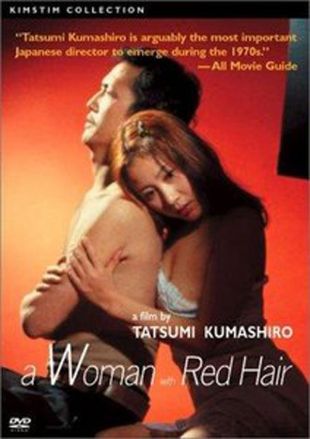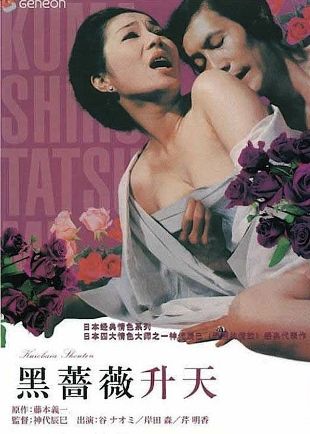Though largely unknown in the West, Tatsumi Kumashiro is arguably the most important Japanese director to emerge during the 1970s. Kumashiro came to prominence during a tumultuous period in Japanese cinema: due to the popularity of television and Hollywood movies, revenues were at an all time low; Japan's finest directors, including Akira Kurosawa and Nagisa Oshima, were forced to seek funding abroad; and the popularity of the yakuza genre, a mainstay for a number of studios, was beginning to wane. Studios were forced into drastic actions in order to forestall their inevitable demise. A once prestigious studio on the verge of bankruptcy, Nikkatsu announced in October 1971 that it would begin mass-producing a variety of soft-core porn called Nikku Roman Porno (literally Nikkatsu Romantic Pornography). Kumashiro's films both popularized this new genre and elevated it into the realm of art cinema.
Born in 1927 in Saga City in the southern island of Kyushu into an old samurai family, Kumashiro was the oldest son of a pharmaceuticals wholesale merchant and judo master. By junior high, he rebelled against both his strict father, who firmly believed in the teachings of the Hagakure (the philosophical text on the virtues of the samurai), and the general militarism of Japan during the early 1940s, by cutting school to read Western literature and see movies. He was particularly impressed by Kurosawa's debut Sugata Sanshiro (1943). In order to avoid the draft, Kumashiro entered the medical department at Kyushu Imperial University in 1945, but he withdrew soon after Japan surrendered the war. Much to his family's chagrin, Tatsumi announced that he had no interest in running the family business, and instead he enrolled in Tokyo's Waseda University to study English literature. Though he always longed to be a novelist, he concluded that he could not support himself doing so, and in 1952, he took and passed the assistant directorship exam at Shochiku studios. In 1955, he moved to Nikkatsu, which was riding a crest of popularity with its youth oriented taiyozoku movies.
Though Kumashiro was on a clear track to direct, he would not helm a film until 1968's Kaburitsuki Jinsei. Stylistically, the film showcased long takes and a gritty visual sensibility that would run throughout his career. After Nikkatsu began to produce roman porno, Kumashiro was presented with a hard choice: make porn or work in television. For someone who spent much of his adult life working toward making films, television was not an appealing option. Kumashiro reluctantly choose roman porno in spite of an industry-wide prejudice against the genre and continual harassment by the Tokyo Metropolitan Police Department for obscenity. Kumashiro's first breakthrough was his first roman porno, Nureta Kuchibiru (1972). The film proved to be a major commercial and critical success -- so much so that the PR department of Nikkatsu asked if Kumashiro would include the word nureta (meaning "wet," with all of its sexual connotations) in his subsequent films.
Japanese critics quickly realized that Kumashiro's work was something more than mere genre films. For his next film, Ichijo Sayuri: Nureta Yokujo (1972), an All About Eve-like tale about strippers, he won a prestigious Kinema Jumpo award for best script, and Hiroko Isayama won a best actress prize. During the next couple years, Kumashiro cranked out movies at a dizzying rate, and in the process, he produced some of his finest works, including Koibitotachi wa Nureta (1973), Akasen Tamanoi: Nuraremasu (1974), and Yojohan Fusuma no Urabari (1973), the last of which is considered to be one of the best Japanese films of the '70s.
Like Shohei Imamura, Kumashiro sets his films in down-and-out communities in the fringe of Japanese society such as the brothel districts of Tokyo or a blue-collar town outside of Osaka. His films portray a rawness and an earthiness that seem to articulate a bawdy sensuousness edged with despair. Kumashiro's characters often use sex as a way to forestall emotional and economic oblivion. At the same time, he punctuates his films with the sort of radical frivolity that recalls Jean-Luc Godard and Seijun Suzuki. One scene in his Maruhi: Shikijo Mesu Ichiba
(1974) features a bank robbery where the get-away vehicle is a balloon. Koibitotachi wa Nureta (1973) climaxes with an interminable naked leapfrog game. At their core, however, Kumashiro's films are (not surprisingly) about relations between the sexes. Recalling the works of bawdy 19th century playwright Ihara Saikaku, Kumashiro populates his films with strong, vibrant, and instinctual women who sacrifice themselves to passion. Male characters are, by contrast, alienated, passive and miserable, as if the weight of society grips them so tightly that rebellion is ultimately impossible.
After a period of making mainstream (non-roman porno) movies, Kumashiro returned to make Akai Kami no Onna (1978) which was named the one of the best films of the year by Kinema Jumpo. Just as Kumashiro's cinematic reputation was cemented at home, Japan's film industry censorship body, which insists that all genitals be blurred out, inhibited Kumashiro's international distribution. The 1976 Cannes Film Festival screened an uncensored print of Akasen Tamanoi: Nukeraremasu, and it received rave reviews from the French Press. Unfortunately, uncensored prints of his other films were not available. Though it was praised by critics and Francois Truffaut hailed it a "great movie," audiences laughed at the blurs during the crucial love scenes in Yojihan Fusuma no Urabari. Luckily, by the '80s, Europe caught up with Kumashiro, and a number of his films are included in programs on Asian cinema in France and Italy.
As the popularity of roman porno began to wane in the early 1980s, Kumashiro's health began to decline. While making Ushi Mitsu no Mura in 1983, he suffered from a collapsed lung. Evoking the never-say-die spirit of the Hagakure, Kumashiro returned and finished the film, which was eventually screened at Cannes. Though his health proceeded to decline, he continued to make movies. His final film, Bo no Kanashimi (1994), was made while he was hooked up to an oxygen tank. Tatsumi Kumashiro died on February 24, 1995, of heart and lung failure.


